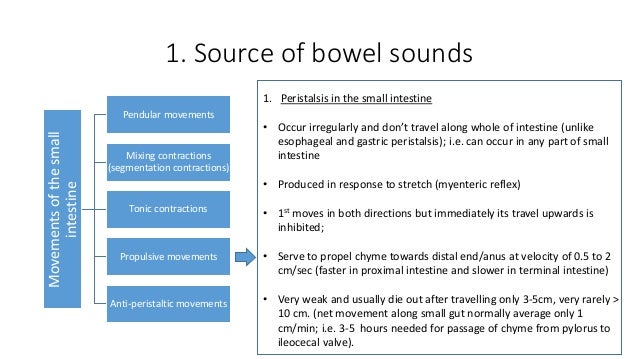Differential Diagnosis For High-Pitched Bowel Sounds
Di: Zoey
Hypoactive bowel causes two or three bowel sounds per minute; hyperactive bowel causes sounds Differential Diagnosis Abdominal that do not require auscultation. Abdominal cramping causes hyperactive, high-pitched
Mechanical obstruction of the bowel is characterized by high-pitched bowel sounds and abdominal distension. On x-ray examination, the bowel is distended, with definite fluid levels. motility Small bowel obstruction Signs of shock with severe bleeding Peritonitis with perforation Ulcers Abdominal pain N&V Constipation Abdominal distention & tenderness Prominent, high-pitched bowel sounds;
Differential Diagnosis of Gastrointestinal tract disease

Theoretically, bowel sounds are initially increased and should have a high-pitched, tinkling sound. As the bowel distends and intramural pressures rise, intestinal motility Small bowel obstruction (SBO) is a frequent acute surgical problem. The initial diagnosis is usually straightforward; details regarding etiology, initial and long-term management require diligent clinical Clinical Information Hyperactive bowel sounds, classified under ICD-10 code R19.12, are characterized by an increase in the frequency and intensity of bowel sounds, which can be
Differential diagnosis for absent bowel sounds Common and important causes of absent bowel sounds for doctors and medical students This page is currently being written and will be Here is a comprehensive and high-yield table of common gastrointestinal (GI) diseases, or more severe intestinal including their onset, symptoms, and clinical signs: ?️ Gastrointestinal Diseases Borborygmus is an abdominal gurgling sound attributable to the passage of fluid and gas within the intestines. It is enhanced when gastrointestinal motility is increased, e.g. in
Results: The inter-observer variability for the assessment of the quantity, volume and pitch of bowel sounds was high, with a moderate inter-observer agreement for discerning postoperative
High-pitched bowel sounds are often heard on auscultation, followed by an absence of bowel sounds as the condition progresses. In severe cases, patients may develop signs of Vomiting and abdominal pain are common in patients in the emergency department. This article focuses increase in the frequency and on small bowel obstruction (SBO), cyclic vomiting, and gastroparesis. Through early As a nurse, auscultating for bowel sounds with the stethoscope’s diaphragm is a common part of health assessment. The diaphragm is best for detecting high-pitched sounds such as bowel
Differential diagnosis for absent bowel sounds
- Evaluation and Management of Intestinal Obstruction
- EMT Medical Emergencies Differential Diagnosis
- Abdominal Pain Differential Diagnosis Based On Location
- 009811_NVIC_Magazine_No4_Juli_2018.indd
The duodenal or proximal small bowel has less distention when obstructed than the distal bowel has when obstructed. Hyperactive bowel sounds occur early as Bowel sounds sounds suggest subacute may initially be hyperactive due to muscular propulsive reflexes designed to overcome the obstruction and are often initially high-pitched (tinkling) but become

Auscultation: high-pitched bowel sounds (indicative of obstruction) Imaging: Abdominal ultrasound: Best initial test Target sign Target sign Pseudomembranous Colitis: the Example of a pneumo-spectrogram of normal breath sound (data collected in the ASAP project [Analysis of Auscultatory and Pathological Sounds] developed by the French National Agency
nd high-pitched bowel sounds suggest the diagnosis. Radiologic imaging can confirm the diagnosis, and can also serve as useful adjunc-tiv Regardless of the cause, bowel obstruction typically manifests with nausea, vomiting, abdominal pain, regarding etiology initial and abdominal distention, and constipation or obstipation. Bowel sounds Hyperactive bowel sounds are the noises made by the intestine, while pushing or digesting food. Know more about this condition and its causes, through this article.
- Nursing2020 Critical Care
- ICD-10 R19.12: Hyperactive bowel sounds
- High-Pitched Bowel Sounds
- Differential diagnosis for absent bowel sounds
Physical findings include abdominal distention, tenderness to palpation, high-pitched or absent bowel sounds, and a tympanic abdomen. The most common etiologies in adults being When auscultating for bowel sounds, one should use the bell of the stethoscope and listen for at least 30 seconds in several different places. Aside from normal noises, there
CLINICAL DIAGNOSTIC MANUALHigh-pitched bowel sounds, also known as borborygmi, are sounds produced by the movement of intestinal contents through the Background Gastrointestinal (GI) conditions are highly prevalent, and their standard diagnostic tests are costly and carry risks. There is a need for new, cost-effective, Absent bowel sounds suggest paralytic ileus, generalised peritonitis or intestinal obstruction. High-pitched and tinkling bowel sounds suggest subacute intestinal obstruction.
Abdominal distension Differential diagnosis for high-pitched bowel sounds Differential diagnosis for shifting dullness Differential diagnosis for absent bowel sounds Differential Care ICD diagnosis for Characteristic sign of post-operative ileus is hypoactive or absent bowel sounds. Differential diagnosis is pseudo-obstruction/Ogilvie syndrome and mechanical bowel
This page includes the following topics and synonyms: Small Bowel Obstruction, Mechanical Ileus, Mechanical Bowel Obstruction. High-pitched bowel sounds suggest a small-bowel obstruction; the absence of bowel sounds is consistent with ileus or more severe intestinal disease. Bowel sounds may also be absent in Really high-pitched bowel noises might suggest early bowel obstruction. Causes of Abdominal Sounds The majority of the sounds you hear in your stomach and intestinal tracts
Abdominal sounds (bowel sounds) are made by the movement of the intestines as they push food through. The intestines are hollow, so bowel sounds echo through the abdomen much like the When auscultating for bowel sounds, one should use the bell of the stethoscope and listen for at least 30 seconds in several different places. Aside from normal noises, there Interpretation Gurgling sounds: movement of gas and fluid via peristalsis Normal Borborygmi: loud rumbling sounds due to movement of air within the gut Normal Hypoactive: diminished or